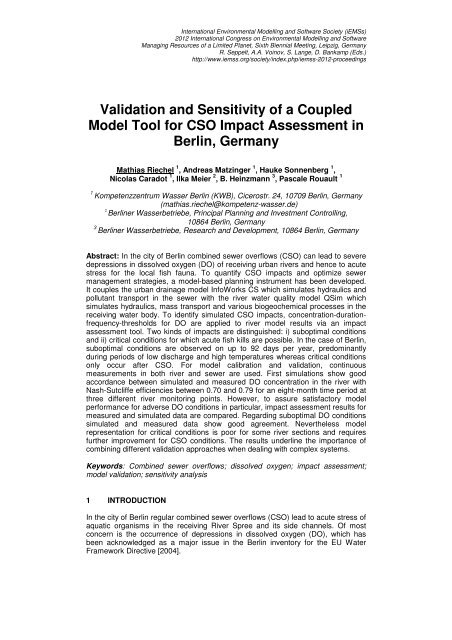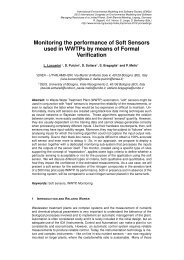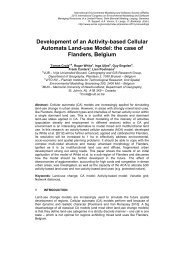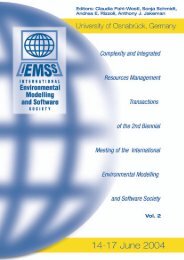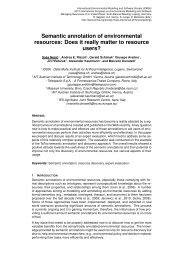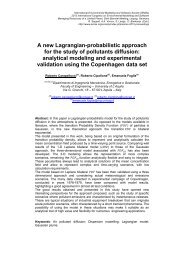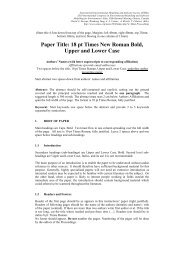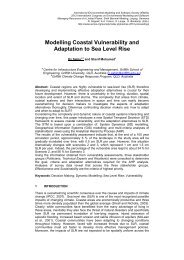Validation and Sensitivity of a Coupled Model Tool for CSO Impact ...
Validation and Sensitivity of a Coupled Model Tool for CSO Impact ...
Validation and Sensitivity of a Coupled Model Tool for CSO Impact ...
You also want an ePaper? Increase the reach of your titles
YUMPU automatically turns print PDFs into web optimized ePapers that Google loves.
International Environmental <strong>Model</strong>ling <strong>and</strong> S<strong>of</strong>tware Society (iEMSs)<br />
2012 International Congress on Environmental <strong>Model</strong>ling <strong>and</strong> S<strong>of</strong>tware<br />
Managing Resources <strong>of</strong> a Limited Planet, Sixth Biennial Meeting, Leipzig, Germany<br />
R. Seppelt, A.A. Voinov, S. Lange, D. Bankamp (Eds.)<br />
http://www.iemss.org/society/index.php/iemss-2012-proceedings<br />
<strong>Validation</strong> <strong>and</strong> <strong>Sensitivity</strong> <strong>of</strong> a <strong>Coupled</strong><br />
<strong>Model</strong> <strong>Tool</strong> <strong>for</strong> <strong>CSO</strong> <strong>Impact</strong> Assessment in<br />
Berlin, Germany<br />
Mathias Riechel 1 , Andreas Matzinger 1 , Hauke Sonnenberg 1 ,<br />
Nicolas Caradot 1 , Ilka Meier 2 , B. Heinzmann 3 , Pascale Rouault 1<br />
1<br />
Kompetenzzentrum Wasser Berlin (KWB), Cicerostr. 24, 10709 Berlin, Germany<br />
(mathias.riechel@kompetenz-wasser.de)<br />
2<br />
Berliner Wasserbetriebe, Principal Planning <strong>and</strong> Investment Controlling,<br />
10864 Berlin, Germany<br />
3<br />
Berliner Wasserbetriebe, Research <strong>and</strong> Development, 10864 Berlin, Germany<br />
Abstract: In the city <strong>of</strong> Berlin combined sewer overflows (<strong>CSO</strong>) can lead to severe<br />
depressions in dissolved oxygen (DO) <strong>of</strong> receiving urban rivers <strong>and</strong> hence to acute<br />
stress <strong>for</strong> the local fish fauna. To quantify <strong>CSO</strong> impacts <strong>and</strong> optimize sewer<br />
management strategies, a model-based planning instrument has been developed.<br />
It couples the urban drainage model InfoWorks CS which simulates hydraulics <strong>and</strong><br />
pollutant transport in the sewer with the river water quality model QSim which<br />
simulates hydraulics, mass transport <strong>and</strong> various biogeochemical processes in the<br />
receiving water body. To identify simulated <strong>CSO</strong> impacts, concentration-durationfrequency-thresholds<br />
<strong>for</strong> DO are applied to river model results via an impact<br />
assessment tool. Two kinds <strong>of</strong> impacts are distinguished: i) suboptimal conditions<br />
<strong>and</strong> ii) critical conditions <strong>for</strong> which acute fish kills are possible. In the case <strong>of</strong> Berlin,<br />
suboptimal conditions are observed on up to 92 days per year, predominantly<br />
during periods <strong>of</strong> low discharge <strong>and</strong> high temperatures whereas critical conditions<br />
only occur after <strong>CSO</strong>. For model calibration <strong>and</strong> validation, continuous<br />
measurements in both river <strong>and</strong> sewer are used. First simulations show good<br />
accordance between simulated <strong>and</strong> measured DO concentration in the river with<br />
Nash-Sutcliffe efficiencies between 0.70 <strong>and</strong> 0.79 <strong>for</strong> an eight-month time period at<br />
three different river monitoring points. However, to assure satisfactory model<br />
per<strong>for</strong>mance <strong>for</strong> adverse DO conditions in particular, impact assessment results <strong>for</strong><br />
measured <strong>and</strong> simulated data are compared. Regarding suboptimal DO conditions<br />
simulated <strong>and</strong> measured data show good agreement. Nevertheless model<br />
representation <strong>for</strong> critical conditions is poor <strong>for</strong> some river sections <strong>and</strong> requires<br />
further improvement <strong>for</strong> <strong>CSO</strong> conditions. The results underline the importance <strong>of</strong><br />
combining different validation approaches when dealing with complex systems.<br />
Keywords: Combined sewer overflows; dissolved oxygen; impact assessment;<br />
model validation; sensitivity analysis<br />
1 INTRODUCTION<br />
In the city <strong>of</strong> Berlin regular combined sewer overflows (<strong>CSO</strong>) lead to acute stress <strong>of</strong><br />
aquatic organisms in the receiving River Spree <strong>and</strong> its side channels. Of most<br />
concern is the occurrence <strong>of</strong> depressions in dissolved oxygen (DO), which has<br />
been acknowledged as a major issue in the Berlin inventory <strong>for</strong> the EU Water<br />
Framework Directive [2004].
M. Riechel et al. / <strong>Validation</strong> <strong>and</strong> <strong>Sensitivity</strong> <strong>of</strong> a <strong>Coupled</strong> <strong>Model</strong> <strong>Tool</strong> <strong>for</strong> <strong>CSO</strong> <strong>Impact</strong> Assessment in<br />
Berlin, Germany<br />
To assess the impacts <strong>of</strong> <strong>CSO</strong> on the Berlin River Spree a model-based planning<br />
instrument has been developed. It will be used by decision makers to study<br />
different sewer management <strong>and</strong> climate change scenarios. The planning<br />
instrument couples<br />
i) the sewer model InfoWorks CS [WSL 2004], which simulates volumes<br />
<strong>and</strong> substance loads <strong>of</strong> <strong>CSO</strong>,<br />
ii) the river water quality model Hydrax/QSim [Kirchesch <strong>and</strong> Schöl 1999;<br />
Oppermann 2010] which simulates the effects <strong>of</strong> these <strong>CSO</strong> on<br />
hydraulics <strong>and</strong> water quality in the receiving water body <strong>and</strong><br />
iii) an impact assessment tool which evaluates <strong>and</strong> quantifies the simulated<br />
effects <strong>of</strong> <strong>CSO</strong> on the receiving river.<br />
Be<strong>for</strong>e employing the coupled model-tool <strong>for</strong> prediction <strong>of</strong> <strong>CSO</strong> impacts in the river,<br />
calibration <strong>and</strong> validation has to be conducted. Both procedures are particularly<br />
important when different models are coupled <strong>and</strong> uncertainties on process<br />
variables, input data or model structure may add up. The assessment <strong>of</strong> the model<br />
per<strong>for</strong>mance is a fundamental part <strong>of</strong> calibration <strong>and</strong> validation, typically basing on<br />
two approaches: i) the subjective (or qualitative) evaluation <strong>of</strong> the model behaviour<br />
via visual inspection <strong>of</strong> simulated <strong>and</strong> observed hydrographs <strong>and</strong> ii) the objective<br />
(or quantitative) evaluation by means <strong>of</strong> mathematical error estimation methods<br />
that quantify the deviation between model results <strong>and</strong> measurements [Krause et al.<br />
2005].<br />
However, both methods might be insufficient in the case <strong>of</strong> the above described<br />
planning instrument <strong>for</strong> <strong>CSO</strong> control. For instance, river model per<strong>for</strong>mance<br />
regarding state-variable DO might be poor in visual terms, e.g. due to a delayed<br />
simulation <strong>of</strong> the resulting DO sag after <strong>CSO</strong>, but nonetheless simulations <strong>and</strong><br />
measurements agree on the frequency <strong>of</strong> adverse DO conditions. On the other<br />
h<strong>and</strong>, model efficiency according to objective goodness-<strong>of</strong>-fit measures, e.g. the<br />
coefficient <strong>of</strong> determination r² or the Nash-Sutcliffe efficiency E [Nash <strong>and</strong> Sutcliffe<br />
1970] could be identified as satisfactory over the simulated time period, even<br />
though critically low DO values after single <strong>CSO</strong> events are not simulated properly.<br />
As a consequence, the use <strong>of</strong> impact assessment parameters, such as the number<br />
<strong>of</strong> days with suboptimal or critical DO conditions, is introduced as a supplementary<br />
step <strong>for</strong> model validation throughout this paper.<br />
First applications <strong>of</strong> the planning instrument aim at testing the sensitivity <strong>of</strong> the<br />
model output to changing boundary conditions. Different sewer management<br />
solutions such as the increase <strong>of</strong> storage volume, the reduction <strong>of</strong> the impervious<br />
area, decentralized treatment <strong>of</strong> storm water run<strong>of</strong>f or end <strong>of</strong> pipe treatment <strong>of</strong><br />
overflow water will be combined with expected climate change effects like<br />
temperature rise or change in rainfall intensity <strong>and</strong> analysed with the coupled model<br />
tool. Once the simulated <strong>CSO</strong> impacts in the river fit well with the observations, the<br />
model tool can support decision makers in finding appropriate sewer management<br />
strategies or analyse the effect <strong>of</strong> future climate change.<br />
2 STUDY SITE<br />
The combined sewer system <strong>of</strong> the city <strong>of</strong> Berlin covers a drained area <strong>of</strong><br />
approximately 100 km² <strong>and</strong> collects storm water <strong>and</strong> sewage <strong>of</strong> 1.5 million<br />
inhabitants via a sewer network <strong>of</strong> 2,000 km length. After intense rainfalls the 180<br />
<strong>CSO</strong> outlets located along the River Spree <strong>and</strong> its side channels can become a<br />
major source <strong>of</strong> pollution. According to estimations <strong>of</strong> the Berlin water utilities 20 to<br />
30 <strong>CSO</strong> events per year are counted on average. However, <strong>CSO</strong> frequency<br />
strongly depends on the spatial <strong>and</strong> temporal distribution <strong>of</strong> rainfall <strong>and</strong> on the<br />
specific properties <strong>of</strong> each sub-catchment (e.g. storage volume, size <strong>of</strong> drainage<br />
area, run<strong>of</strong>f coefficient).<br />
The receiving River Spree is a flow-regulated lowl<strong>and</strong> river <strong>of</strong> 50 to 70 m width <strong>and</strong><br />
2 to 3 m depth. It has an average monthly discharge between 12 <strong>and</strong> 45 m³ s -1
M. Riechel et al. / <strong>Validation</strong> <strong>and</strong> <strong>Sensitivity</strong> <strong>of</strong> a <strong>Coupled</strong> <strong>Model</strong> <strong>Tool</strong> <strong>for</strong> <strong>CSO</strong> <strong>Impact</strong> Assessment in<br />
Berlin, Germany<br />
(time period: 2000 to 2010) with flow velocities between 6 <strong>and</strong> 24 cm s -1 . The Berlin<br />
section <strong>of</strong> the River Spree is strongly affected by various human activities leading to<br />
a highly degraded river morphology, homogeneous river substrates <strong>and</strong> reduced<br />
biodiversity [Leszinski et al. 2007]. Periodic <strong>CSO</strong> events implicate additional stress<br />
to the ecology <strong>of</strong> the urban water courses.<br />
The simulated stretch <strong>of</strong> the River Spree <strong>and</strong> its side channels has a total length <strong>of</strong><br />
27 km <strong>and</strong> receives storm water <strong>and</strong> sewage from 67 <strong>CSO</strong> outlets each <strong>of</strong> which is<br />
represented in both the urban drainage model <strong>and</strong> the river water quality model<br />
(Figure 1).<br />
Figure 1. Map <strong>of</strong> the city <strong>of</strong> Berlin with its main waterways (black), the combined<br />
sewer area (dark grey area) <strong>and</strong> the simulated river stretch (light grey lines).<br />
3 MATERIAL AND METHODS<br />
3.1 Dynamic models<br />
Since the Berlin sewer system is highly complex with little slope at most reaches,<br />
flow in the sewer is simulated hydrodynamically with the s<strong>of</strong>tware package<br />
InfoWorks CS [WSL 2004]. InfoWorks CS solves the full St. Venant equations <strong>and</strong><br />
thus accounts <strong>for</strong> backwater effects <strong>and</strong> reverse flow, both <strong>of</strong> which occur in the<br />
Berlin sewer system. In terms <strong>of</strong> pollutants it simulates the transport <strong>of</strong> dissolved<br />
<strong>and</strong> solid fractions <strong>of</strong> biochemical oxygen dem<strong>and</strong> (BOD), chemical oxygen<br />
dem<strong>and</strong> (COD), ammonium (NH 4 ), total Kjeldahl nitrogen (TKN), total suspended<br />
solids (TSS), total phosphorus (TP) <strong>and</strong> ortho-phosphate (PO 4 ). Degradation<br />
processes are not considered assuming that the travel time in sewers is too short<br />
<strong>for</strong> significant decay <strong>of</strong> constituents. The Berlin model is calibrated <strong>and</strong> validated<br />
based on measurements taken with online probes in a major overflow sewer<br />
[Caradot et al. 2011].<br />
For the simulation <strong>of</strong> DO dynamics in the river, the hydraulic model Hydrax<br />
[Oppermann 2010] with the coupled complex water quality model QSim [Kirchesch<br />
<strong>and</strong> Schöl 1999], developed at the German Federal Institute <strong>of</strong> Hydrology (BfG)<br />
were chosen. The hydraulic model Hydrax solves the full St. Venant equations <strong>and</strong><br />
allows simulating various special features that affect river hydraulics, such as<br />
macrophyte cover or spur dykes. The water quality model QSim calculates onedimensional<br />
transport <strong>and</strong> reactions <strong>of</strong> all major water quality parameters, covering<br />
a great number <strong>of</strong> biological parameters, including both planktonic <strong>for</strong>ms that move<br />
with the water (green algae, diatoms, cyanobacteria <strong>and</strong> rotifers) <strong>and</strong> sessile
M. Riechel et al. / <strong>Validation</strong> <strong>and</strong> <strong>Sensitivity</strong> <strong>of</strong> a <strong>Coupled</strong> <strong>Model</strong> <strong>Tool</strong> <strong>for</strong> <strong>CSO</strong> <strong>Impact</strong> Assessment in<br />
Berlin, Germany<br />
species (benthic algae, macrophytes <strong>and</strong> filter feeders) [Schöl et al. 1999; Schöl et<br />
al. 2002]. For model calibration <strong>and</strong> validation long-term continuous measurements<br />
at several river points are considered.<br />
For the link between the sewer <strong>and</strong> the water quality model, each <strong>of</strong> the 67 <strong>CSO</strong><br />
outlets simulated with InfoWorks CS is represented by a separate inlflow in<br />
Hydrax/QSim to resolve the spatial distribution <strong>of</strong> <strong>CSO</strong> impacts along the river.<br />
Although the sewer model simulates the most critical parameters <strong>for</strong> DO<br />
depressions in the river (e.g. BOD, COD, TSS, NH 4 ) it does not cover all state<br />
variables <strong>of</strong> QSim. Accordingly, assumptions have been made on parameters such<br />
as phytoplankton (which is probably close to zero in the sewer) or DO (which is<br />
assumed to be 0 mg L -1 in <strong>CSO</strong>).<br />
3.2 <strong>CSO</strong> impact assessment<br />
Regarding impact assessment the quality st<strong>and</strong>ards proposed by Lammersen<br />
[1997] <strong>for</strong> lowl<strong>and</strong> rivers are applied to measured <strong>and</strong> simulated water quality data<br />
<strong>of</strong> the River Spree. The Lammersen-approach defines DO thresholds <strong>for</strong> eight<br />
exposure durations ranging from 10 minutes to 24 hours (Figure 2). For each<br />
threshold temperature-dependent correction factors are used, since the oxygen<br />
dem<strong>and</strong> <strong>of</strong> aquatic organisms depends on the water temperature [Downing <strong>and</strong><br />
Merkens 1957]. The protocol aims at protecting fish <strong>and</strong> invertebrates from any<br />
adverse effect ranging from impairment <strong>of</strong> swimming behaviour to death.<br />
Throughout this paper, a time period is classified as an event with suboptimal<br />
conditions, when at least one <strong>of</strong> the eight concentration-duration-criteria is met.<br />
In addition to these suboptimal conditions, the LC 50 -value <strong>of</strong> the asp (aspius<br />
aspius), the fish species <strong>of</strong> the River Spree that is most sensitive to low DO, was<br />
chosen as a second quality st<strong>and</strong>ard <strong>for</strong> highly critical conditions. If DO<br />
concentration remains below 2 mg L -1 <strong>for</strong> more than 30 minutes, lethal impacts on<br />
aquatic organisms have to be expected. This approach follows Buikema <strong>and</strong><br />
Benfield [1980] who suggest to focus on the requirements <strong>of</strong> the least tolerant<br />
species, to protect the local biocenosis as a whole. Figure 2 illustrates the quality<br />
st<strong>and</strong>ards <strong>for</strong> both suboptimal <strong>and</strong> critical conditions.<br />
Figure 2. Quality st<strong>and</strong>ards <strong>for</strong> <strong>CSO</strong> impact assessment. Thresholds <strong>for</strong><br />
suboptimal conditions are adapted from Lammersen [1997] <strong>and</strong> are defined as a<br />
function <strong>of</strong> duration <strong>and</strong> temperature. The threshold <strong>for</strong> critical conditions refers to<br />
the LC 50 -value <strong>of</strong> the asp (aspius aspius).<br />
To provide a semiautomatic <strong>and</strong> st<strong>and</strong>ardised tool <strong>for</strong> the evaluation <strong>of</strong> model<br />
results a database application <strong>for</strong> <strong>CSO</strong> impact assessment has been developed.<br />
The application provides a graphical interface allowing the user to select the
M. Riechel et al. / <strong>Validation</strong> <strong>and</strong> <strong>Sensitivity</strong> <strong>of</strong> a <strong>Coupled</strong> <strong>Model</strong> <strong>Tool</strong> <strong>for</strong> <strong>CSO</strong> <strong>Impact</strong> Assessment in<br />
Berlin, Germany<br />
simulated DO time series <strong>of</strong> a certain scenario. The chosen time series is then<br />
analysed by successively comparing it to the quality st<strong>and</strong>ards described above.<br />
Results are provided in terms <strong>of</strong> tables <strong>and</strong> graphs, displaying the number <strong>of</strong> events<br />
<strong>and</strong> calendar days with suboptimal or critical conditions at different points in the<br />
River Spree. The impact assessment tool was established primarily <strong>for</strong> comparison<br />
<strong>of</strong> scenarios regarding their impact in the river. However, it also allows validation <strong>of</strong><br />
model results with respect to the occurrence <strong>of</strong> suboptimal/critical DO conditions.<br />
4 RESULTS AND DISCUSSION<br />
Coupling <strong>of</strong> the sewer <strong>and</strong> the river water quality model has been successfully<br />
demonstrated <strong>for</strong> the eight-month time period April to November 2010.<br />
4.1 Sewer model<br />
In the time period April to November 2010 a total <strong>CSO</strong> volume <strong>of</strong> 2.9 million m³ was<br />
simulated to have entered the River Spree. Half <strong>of</strong> that volume was discharged<br />
during only five <strong>CSO</strong> events. For an exemplary storm event on 23 July 2010 sewer<br />
simulations with InfoWorks CS identified an overflow volume <strong>of</strong> 4,480 m³ <strong>and</strong><br />
pollutant loadings <strong>of</strong> 51 kg, 251 kg <strong>and</strong> 811 kg <strong>for</strong> BOD, COD <strong>and</strong> TSS at a<br />
monitored <strong>CSO</strong> outlet at km 9.7 <strong>of</strong> the modelled river stretch. Figure 3 shows the<br />
rain intensity <strong>and</strong> the simulated <strong>and</strong> measured water flow (left panel) as well as the<br />
simulated <strong>and</strong> measured loadings <strong>of</strong> TSS (right panel) at the observed outlet.<br />
Figure 3. Measured <strong>and</strong> simulated water flow (left panel) <strong>and</strong> loadings <strong>of</strong> total<br />
suspended solids (TSS) (right panel) at a major overflow sewer during a storm<br />
event on 23 July 2010 with a total rain height <strong>of</strong> 22.7 mm.<br />
4.2 <strong>Coupled</strong> sewer <strong>and</strong> river model<br />
The seasonal pattern <strong>of</strong> goal state variable DO is well represented by the coupled<br />
model <strong>for</strong> the entire simulated time period (Figure 4, left panel). Quantitative<br />
evaluation <strong>of</strong> model per<strong>for</strong>mance yielded Nash-Sutcliffe-efficiencies between 0.70<br />
<strong>and</strong> 0.79 at different monitoring stations. Looking at the specific <strong>CSO</strong> event shown<br />
in Figure 3, the river water quality model QSim shows a significant drop in dissolved<br />
oxygen to 3.5 mg L -1 at km 10.3 <strong>of</strong> the modelled river stretch 600 m downstream <strong>of</strong><br />
the <strong>CSO</strong> structure (Figure 4, right panel, dotted line). However, visual inspection<br />
shows that DO depression in the River Spree is not simulated to the same extent<br />
as indicated by measurements. In particular, the lowest DO occurrence is not met<br />
by the model. Thus, satisfactory Nash-Sutcliffe-efficiencies obtained <strong>for</strong> the eightmonth<br />
simulation period described above do not necessarily imply that all observed<br />
DO depressions can be properly predicted with the model tool.
M. Riechel et al. / <strong>Validation</strong> <strong>and</strong> <strong>Sensitivity</strong> <strong>of</strong> a <strong>Coupled</strong> <strong>Model</strong> <strong>Tool</strong> <strong>for</strong> <strong>CSO</strong> <strong>Impact</strong> Assessment in<br />
Berlin, Germany<br />
Figure 4. Measured <strong>and</strong> simulated concentrations <strong>of</strong> dissolved oxygen (DO) at a<br />
<strong>CSO</strong> affected river point. The left panel shows daily averages <strong>for</strong> the eight-month<br />
period April to November 2010. The right panel shows 15-min-values during a<br />
storm event on 23 July 2010.<br />
4.3 <strong>CSO</strong> <strong>Impact</strong> assessment<br />
Applying the two impact assessment approaches described above to measured<br />
<strong>and</strong> simulated data <strong>of</strong> the year 2010 shows good agreement regarding encountered<br />
suboptimal DO conditions (Figure 5, upper panel). According to simulations, DO<br />
concentration has been low enough to potentially harm aquatic organisms on 50 to<br />
54 calendar days, whereas measurements indicate between 34 <strong>and</strong> 50 calendar<br />
days with suboptimal conditions depending on the river section looked at. However,<br />
the coupled model tool shows significant drawbacks when it comes to<br />
representation <strong>of</strong> critical DO conditions (DO < 2 mg L -1 <strong>for</strong> ≥ 30 minutes). While<br />
such conditions are measured on up to 4 days at a highly <strong>CSO</strong>-influenced river<br />
section in the city centre (km 4.8), simulations show no critical conditions at all<br />
(Figure 5, lower panel), indicating insufficient model representation <strong>of</strong> low DO<br />
concentrations. Since the occurrence <strong>of</strong> DO concentrations below 2 mg L -1 is the<br />
main reason <strong>for</strong> occasional fish kills in the Berlin River Spree, further improvement<br />
is necessary to obtain a reliable instrument <strong>for</strong> <strong>CSO</strong> control.<br />
Figure 5. Quantification <strong>of</strong> suboptimal (upper panel) <strong>and</strong> critical DO conditions<br />
(lower panel) at four locations along the river (km 0, km 4.8, km 9.0, km 10.3)<br />
according to measured <strong>and</strong> simulated data <strong>for</strong> 2010.
M. Riechel et al. / <strong>Validation</strong> <strong>and</strong> <strong>Sensitivity</strong> <strong>of</strong> a <strong>Coupled</strong> <strong>Model</strong> <strong>Tool</strong> <strong>for</strong> <strong>CSO</strong> <strong>Impact</strong> Assessment in<br />
Berlin, Germany<br />
4.4 <strong>Model</strong> sensitivity<br />
Both the sewer <strong>and</strong> the river water quality model have been successfully calibrated<br />
to dry weather conditions. Currently, improved calibration to <strong>CSO</strong> conditions is<br />
conducted <strong>for</strong> both models. When calibration aims at adapting urban drainage<br />
parameters, it has to be assured that not only the sewer but also the river water<br />
quality model reacts sensitively regarding goal state variable DO. Sensitive<br />
behaviour to changing model input is not only fundamental when calibrating a<br />
model. It is also the basic prerequisite <strong>for</strong> using the model tool <strong>for</strong> the comparison<br />
<strong>of</strong> different sewer management <strong>and</strong> climate change scenarios. Again, the sensitivity<br />
<strong>of</strong> simulated impacts in the river to changes in boundary conditions should be<br />
assessed by looking at both DO concentration <strong>and</strong> the number <strong>of</strong> days with<br />
suboptimal or critical conditions.<br />
First results on the sensitivity <strong>of</strong> goal variable DO to <strong>CSO</strong> pollutant concentrations<br />
show that <strong>for</strong> the tested range <strong>of</strong> input values the minimum DO concentration<br />
simulated in the river nearly depends linearly on the biochemical oxygen dem<strong>and</strong><br />
(BOD) simulated in spill water (Figure 6, left panel). Changes in river model input<br />
via adaptation <strong>of</strong> the sewer model can improve representation <strong>of</strong> <strong>CSO</strong> impacts in<br />
the river. For the studied storm event on 23 July 2010, a BOD increase <strong>of</strong> 100 %<br />
(e.g. due to sewer model calibration) would lead to a decrease <strong>of</strong> the lowest DO<br />
concentration by 40 % (Figure 6, right panel, dotted line). Hence, DO in the river<br />
would remain below 2 mg L -1 <strong>for</strong> more than 30 minutes, better agreeing with<br />
measurements on the occurrence <strong>of</strong> critical DO conditions.<br />
Figure 6. <strong>Sensitivity</strong> <strong>of</strong> dissolved oxygen (DO) in the river to changing biochemical<br />
oxygen dem<strong>and</strong> (BOD) in <strong>CSO</strong> <strong>for</strong> a storm event on 23 July 2010. Left panel shows<br />
the lowest resulting DO concentration <strong>for</strong> different BOD input concentrations. Right<br />
panel shows measured <strong>and</strong> simulated DO time series <strong>for</strong> four different BOD input<br />
concentrations.<br />
5 CONCLUSIONS<br />
The results indicate that the simulation <strong>of</strong> <strong>CSO</strong> impacts in receiving rivers is<br />
possible at good quality through the coupling <strong>of</strong> a sewer model with a river water<br />
quality model. Even <strong>for</strong> complex urban water systems such as the Berlin River<br />
Spree, highly interdependent state variables such as DO can be simulated at high<br />
temporal resolution. Classical validation <strong>of</strong> model results by visual evaluation <strong>and</strong><br />
the use <strong>of</strong> conventional goodness-<strong>of</strong>-fit measures demonstrated good agreement<br />
with DO concentrations measured in the river. In contrast, application <strong>of</strong> legislative<br />
goal functions revealed shortcomings in the per<strong>for</strong>mance <strong>of</strong> the model tool. The<br />
four most severe DO depressions observed in the studied 8-month time period<br />
could not be represented by the model tool. While these four depressions were<br />
rather short with a total duration <strong>of</strong> only 24.5 hours, they are expected to be most<br />
critical <strong>for</strong> the river ecosystem. Since the improvement <strong>of</strong> the ecological quality is
M. Riechel et al. / <strong>Validation</strong> <strong>and</strong> <strong>Sensitivity</strong> <strong>of</strong> a <strong>Coupled</strong> <strong>Model</strong> <strong>Tool</strong> <strong>for</strong> <strong>CSO</strong> <strong>Impact</strong> Assessment in<br />
Berlin, Germany<br />
the main objective <strong>of</strong> the future use <strong>of</strong> the coupled model tool, further development<br />
is necessary regarding the representation <strong>of</strong> such situations.<br />
We conclude that coupled model tools can be valuable instruments <strong>for</strong> decision<br />
makers to find appropriate strategies <strong>for</strong> <strong>CSO</strong> control or to analyse the expected<br />
impact <strong>of</strong> climate change on the river. However, <strong>for</strong> validation <strong>of</strong> model results it is<br />
crucial to compare model output <strong>and</strong> measurements with regards to legislative<br />
goals in addition to conventional validation methods. By that it can be provided that<br />
the planning instrument is able to meet the specific requirements <strong>of</strong> <strong>CSO</strong><br />
representation. Once the model tool is validated, its sensitivity to realistic changes<br />
in boundary conditions such as the increase <strong>of</strong> storage volume or the reduction <strong>of</strong><br />
the impervious area needs be tested. The analysed change scenarios should be<br />
developed in close cooperation with local decision makers to provide that only<br />
realistic solutions or effects will be considered already at the testing stage. Only<br />
after validation with legislative goal functions <strong>and</strong> sensitivity analysis <strong>for</strong> feasible<br />
change scenarios, the model tool should be used to support specific planning.<br />
ACKNOWLEDGMENTS<br />
The presented work is a result <strong>of</strong> the KWB research project MIA-<strong>CSO</strong> <strong>and</strong> the EU<br />
FP7 project PREPARED. <strong>Model</strong>ling <strong>and</strong> monitoring ef<strong>for</strong>ts in Berlin are financially<br />
supported by Veolia Water, Berliner Wasserbetriebe <strong>and</strong> the Berlin Senate<br />
Department <strong>for</strong> Urban Development <strong>and</strong> the Environment. We kindly thank Volker<br />
Kirchesch <strong>and</strong> his colleagues at the German Federal Institute <strong>for</strong> Hydrology (BfG)<br />
<strong>for</strong> the constant development <strong>and</strong> support regarding the modelling s<strong>of</strong>tware QSim.<br />
REFERENCES<br />
Buikema, A. L., <strong>and</strong> E. F. Benfield. 1980. Synthesis <strong>of</strong> miscellaneous invertebrate toxicity<br />
tests, p. 174-187. Aquatic Invertebrate Bioassays. American Society <strong>for</strong> Testing <strong>and</strong><br />
Materials.<br />
Caradot, N., H. Sonnenberg, M. Riechel, B. Heinzmann, D. v. Seggern, A. Matzinger, <strong>and</strong> P.<br />
Rouault. 2011. Application <strong>of</strong> online water quality sensors <strong>for</strong> integrated <strong>CSO</strong> impact<br />
assessment in Berlin (Germany). Proceedings <strong>for</strong> 12th International Conference on<br />
Urban Drainage, 10-15 September 2011, Porto Alegre, Brazil.<br />
Downing, K. M., <strong>and</strong> J. C. Merkens. 1957. The Influence <strong>of</strong> Temperature on the Survival <strong>of</strong><br />
several Species <strong>of</strong> Fish in Low Tensions <strong>for</strong> Dissolved Oxygen. Annals <strong>of</strong> Applied<br />
Biology 45: 261-267.<br />
Kirchesch, V., <strong>and</strong> A. Schöl. 1999. Das Gewassergütemodell QSIM - Ein Instrument zur<br />
Simulation und Prognose des St<strong>of</strong>fhaushalts und der Planktondynamik von<br />
Fliessgewässern. Hydrologie und Wasserbewirtschaftung 43: 302-309.<br />
Krause, P., D. P. Boyle, <strong>and</strong> F. Bäse. 2005. Comparison <strong>of</strong> different efficiency criteria <strong>for</strong><br />
hydrological model assessment. Advances in Geosciences 5: 89-97.<br />
Lammersen, R. 1997. Die Auswirkungen der Stadtentwässerung auf den St<strong>of</strong>fhaushalt von<br />
Fließgewässern. Schriftenreihe für Stadtentwässerung und Gewässerschutz des<br />
Institutes für Wasserwirtschaft der Universität Hannover, Heft 15.<br />
Leszinski, M., F. Schumacher, K. Schroeder, E. Pawlowsky-Reusing, <strong>and</strong> B. Heinzmann.<br />
2007. ISM Teilstudie: Immissionsorientierte Bewertung von Mischwasserentlastungen in<br />
Tiefl<strong>and</strong>flüssen, p. 40. Kompetenzzentrum Wasser Berlin gGmbH.<br />
Nash, J. E., <strong>and</strong> J. V. Sutcliffe. 1970. River flow <strong>for</strong>ecasting through conceptual models –<br />
Part 1 – A discussion <strong>of</strong> principals. Journal <strong>of</strong> Hydrology 10: 282-290.<br />
Oppermann, R. 2010. Das Programmsystem Hydrax 5.0. Mathematisches <strong>Model</strong>l und<br />
Datenschnittstellen., p. 13.<br />
Schöl, A., V. Kirchesch, T. Bergfeld, <strong>and</strong> D. Müller. 1999. <strong>Model</strong>-based analysis <strong>of</strong> oxygen<br />
budget <strong>and</strong> biological processes in the regulated rivers Moselle <strong>and</strong> Saar: <strong>Model</strong>ling the<br />
influence <strong>of</strong> benthic filter feeders on phytoplankton. Hydrobiologia 410: 167-176.<br />
Schöl, A., V. Kirchesch, T. Bergfeld, F. Schöll, J. Borcherding, <strong>and</strong> D. Müller. 2002.<br />
<strong>Model</strong>ling the chlorophyll a content <strong>of</strong> the River Rhine interrelation between riverine algal<br />
production <strong>and</strong> population biomass <strong>of</strong> grazers, rotifers <strong>and</strong> the zebra mussel, Dreissena<br />
polymorpha. International Review <strong>of</strong> Hydrobiology 87: 295-317.<br />
Senatsverwaltung für Stadtentwicklung Berlin. 2004. Dokumentation der Umsetzung der<br />
EU-Wasserrahmenrichtlinie in Berlin (Länderbericht). Phase: Best<strong>and</strong>saufnahme.<br />
WSL. 2004. InfoWorks CS User Manual. Copyright 1997. Walling<strong>for</strong>d S<strong>of</strong>tware Ltd.


